FIAT ULYSSE 2007 2.G Owners Manual
Manufacturer: FIAT, Model Year: 2007, Model line: ULYSSE, Model: FIAT ULYSSE 2007 2.GPages: 254, PDF Size: 3.42 MB
Page 201 of 254
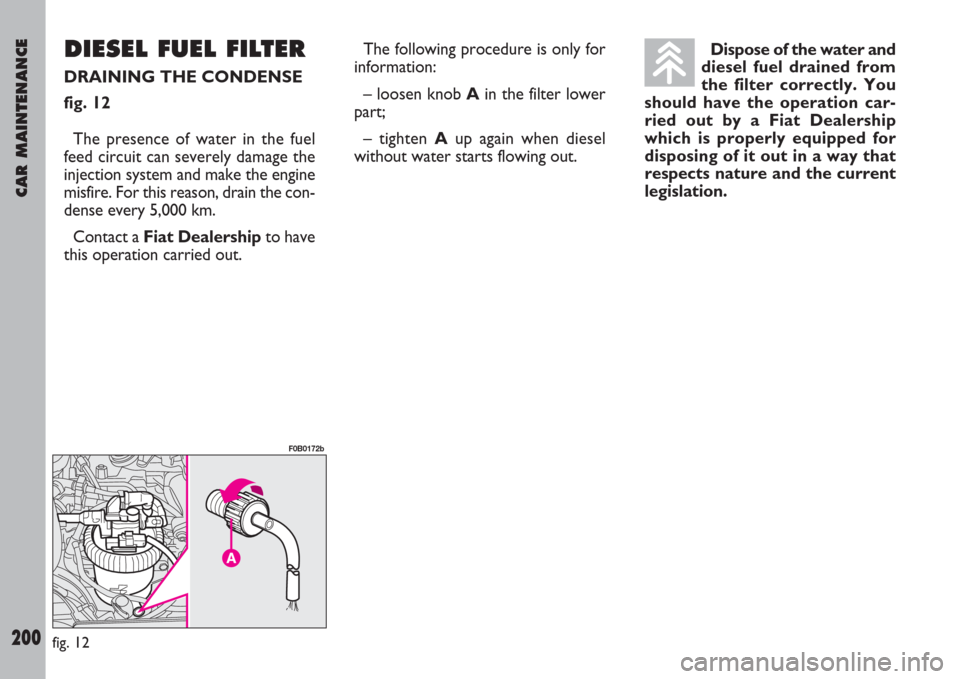
DIESEL FUEL FILTER
DRAINING THE CONDENSE
fig. 12
The presence of water in the fuel
feed circuit can severely damage the
injection system and make the engine
misfire. For this reason, drain the con-
dense every 5,000 km.
Contact a Fiat Dealershipto have
this operation carried out.The following procedure is only for
information:
– loosen knob Ain the filter lower
part;
– tighten Aup again when diesel
without water starts flowing out.Dispose of the water and
diesel fuel drained from
the filter correctly. You
should have the operation car-
ried out by a Fiat Dealership
which is properly equipped for
disposing of it out in a way that
respects nature and the current
legislation.
fig. 12
F0B0172b
CAR MAINTENANCE
200
Page 202 of 254
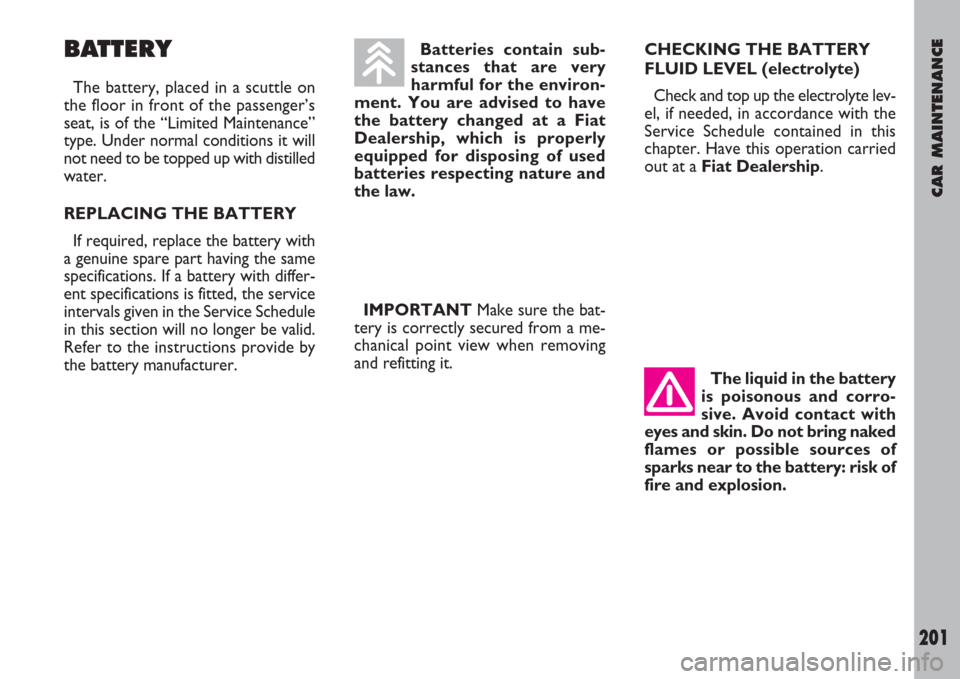
CAR MAINTENANCE
201
BATTERY
The battery, placed in a scuttle on
the floor in front of the passenger’s
seat, is of the “Limited Maintenance”
type. Under normal conditions it will
not need to be topped up with distilled
water.
REPLACING THE BATTERY
If required, replace the battery with
a genuine spare part having the same
specifications. If a battery with differ-
ent specifications is fitted, the service
intervals given in the Service Schedule
in this section will no longer be valid.
Refer to the instructions provide by
the battery manufacturer.Batteries contain sub-
stances that are very
harmful for the environ-
ment. You are advised to have
the battery changed at a Fiat
Dealership, which is properly
equipped for disposing of used
batteries respecting nature and
the law.
IMPORTANTMake sure the bat-
tery is correctly secured from a me-
chanical point view when removing
and refitting it.CHECKING THE BATTERY
FLUID LEVEL (electrolyte)
Check and top up the electrolyte lev-
el, if needed, in accordance with the
Service Schedule contained in this
chapter. Have this operation carried
out at a Fiat Dealership.
The liquid in the battery
is poisonous and corro-
sive. Avoid contact with
eyes and skin. Do not bring naked
flames or possible sources of
sparks near to the battery: risk of
fire and explosion.
Page 203 of 254

Do not attempt to
recharge a frozen bat-
tery. Thaw it first other-
wise it could explode. If the bat-
tery froze, make sure the inter-
nal elements are not broken
(short-circuit risk) and that the
casing is not cracked (risk of
spilling the poisonous and corro-
sive fluid).Incorrect fitting of elec-
trical and electronic ac-
cessories can seriously
damage the vehicle. If after buy-
ing the car, you want to install
other accessories, contact a Fiat
Dealership whose qualified per-
sonnel, in addition to suggesting
the most suitable devices, will
evaluate whether the car’s elec-
tric system should be integrated
with a more powerful battery.
CAR MAINTENANCE
202
When working on the
battery or near it, always
wear the proper goggles.
Running the battery
with low fluid level can
damage the battery be-
yond repair and could also cause
its explosion.
If the car is left inactive
for long periods at cold,
remove the battery and
store it in a warm place to pre-
vent freezing.
Page 204 of 254

CAR MAINTENANCE
203
USEFUL ADVICE FOR
LENGTHENING THE LIFE
OF YOUR BATTERY
To preserve the battery charge and
its functions, observe the following in-
structions:
– when you park the car, ensure the
doors, tailgate and bonnet are closed
properly. The ceiling lights must be off;
– the battery cables must be well fas-
tened;
– do not keep accessories (e.g.:
sound system, hazard lights, etc.)
switched on for a long time when the
engine is not running;
– before performing any operation
on the electrical system, disconnect
the battery negative cable.IMPORTANTA battery which is
kept at a charge of less than 50% for
any length of time will be damaged by
sulphation leading to a reduction in
cranking power and a higher risk of
the battery electrolyte freezing (this
may even occur at –10°C). If the car
is inactive for a long period of time, re-
fer to “Storing the car”, in “Getting to
know your car” section.If after buying the car, you want to
install electric accessories which re-
quire permanent electric supply, con-
tact a Fiat Dealership, whose qual-
ified personnel, in addition to sug-
gesting the most suitable devices be-
longing to the Lineaccessori Fiat, will
evaluate the overall electric absorp-
tion, checking whether the vehicle’s
electric system is capable of with-
standing the load required, or whether
it should be integrated with a more
powerful battery.
Page 205 of 254
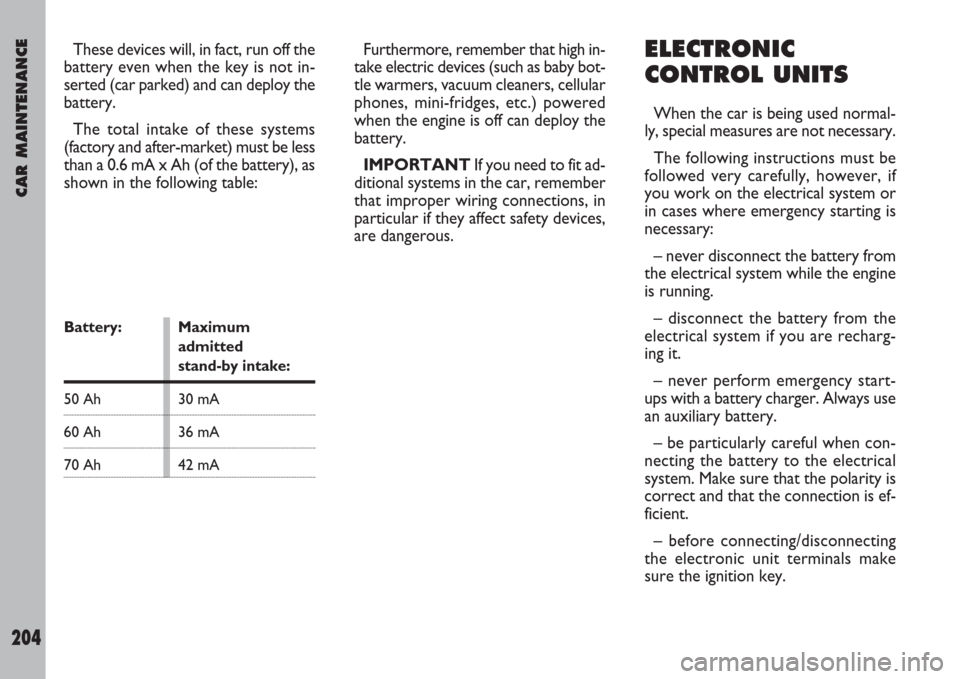
CAR MAINTENANCE
204
These devices will, in fact, run off the
battery even when the key is not in-
serted (car parked) and can deploy the
battery.
The total intake of these systems
(factory and after-market) must be less
than a 0.6 mA x Ah (of the battery), as
shown in the following table:
Battery:
50 Ah
60 Ah
70 AhMaximum
admitted
stand-by intake:
30 mA
36 mA
42 mA
Furthermore, remember that high in-
take electric devices (such as baby bot-
tle warmers, vacuum cleaners, cellular
phones, mini-fridges, etc.) powered
when the engine is off can deploy the
battery.
IMPORTANTIf you need to fit ad-
ditional systems in the car, remember
that improper wiring connections, in
particular if they affect safety devices,
are dangerous.ELECTRONIC
CONTROL UNITS
When the car is being used normal-
ly, special measures are not necessary.
The following instructions must be
followed very carefully, however, if
you work on the electrical system or
in cases where emergency starting is
necessary:
– never disconnect the battery from
the electrical system while the engine
is running.
– disconnect the battery from the
electrical system if you are recharg-
ing it.
– never perform emergency start-
ups with a battery charger. Always use
an auxiliary battery.
– be particularly careful when con-
necting the battery to the electrical
system. Make sure that the polarity is
correct and that the connection is ef-
ficient.
– before connecting/disconnecting
the electronic unit terminals make
sure the ignition key.
Page 206 of 254

CAR MAINTENANCE
205
– do not check polarity through
sparking.
– disconnect the electronic units if
you are electrically welding the car
body. Remove the units if tempera-
tures exceed 80°C.WHEELS AND TYRES
TYRE PRESSURE
Check the pressure of each tyre, in-
cluding the spare, every two weeks
and before long journeys.
The pressure should be checked with
the tyre rested and cold.
It is normal for the pressure to rise
when you are driving. If you have to
check or restore the pressure when
the tyres are warm, remember that
the pressure value must be 0.3 bar
above the specified value.
See “Wheels” in “Technical specifi-
cations” chapter for the correct tyre
inflation pressure.Tyre pressure must be
correct to ensure good
road holding.
Wrong pressure causes uneven wear
of the tyres fig. 13:
A- Correct pressure: tyre wears
evenly.
B- Under inflated tyre: shoulder
tread wear.
C- Over-inflated tyre: centre tread
wear. Modifications or repairs
to the electrical system
carried out incorrectly
and without bearing the features
of the system in mind can cause
malfunctions with the risk of fire.
Page 207 of 254
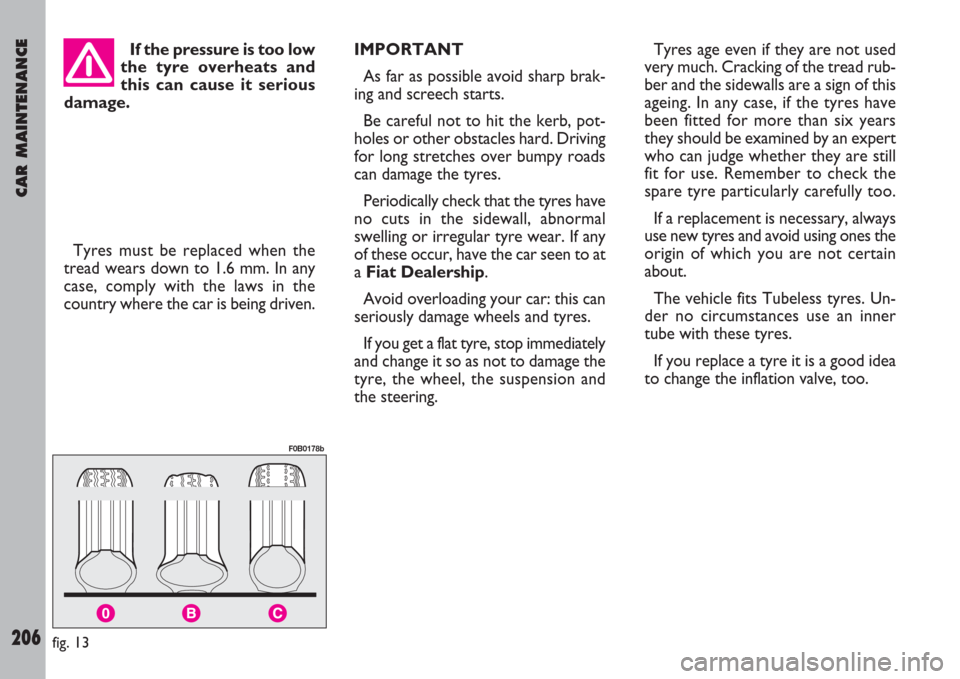
CAR MAINTENANCE
206
If the pressure is too low
the tyre overheats and
this can cause it serious
damage.
Tyres must be replaced when the
tread wears down to 1.6 mm. In any
case, comply with the laws in the
country where the car is being driven.IMPORTANT
As far as possible avoid sharp brak-
ing and screech starts.
Be careful not to hit the kerb, pot-
holes or other obstacles hard. Driving
for long stretches over bumpy roads
can damage the tyres.
Periodically check that the tyres have
no cuts in the sidewall, abnormal
swelling or irregular tyre wear. If any
of these occur, have the car seen to at
a Fiat Dealership.
Avoid overloading your car: this can
seriously damage wheels and tyres.
If you get a flat tyre, stop immediately
and change it so as not to damage the
tyre, the wheel, the suspension and
the steering.Tyres age even if they are not used
very much. Cracking of the tread rub-
ber and the sidewalls are a sign of this
ageing. In any case, if the tyres have
been fitted for more than six years
they should be examined by an expert
who can judge whether they are still
fit for use. Remember to check the
spare tyre particularly carefully too.
If a replacement is necessary, always
use new tyres and avoid using ones the
origin of which you are not certain
about.
The vehicle fits Tubeless tyres. Un-
der no circumstances use an inner
tube with these tyres.
If you replace a tyre it is a good idea
to change the inflation valve, too.
fig. 13
F0B0178b
Page 208 of 254
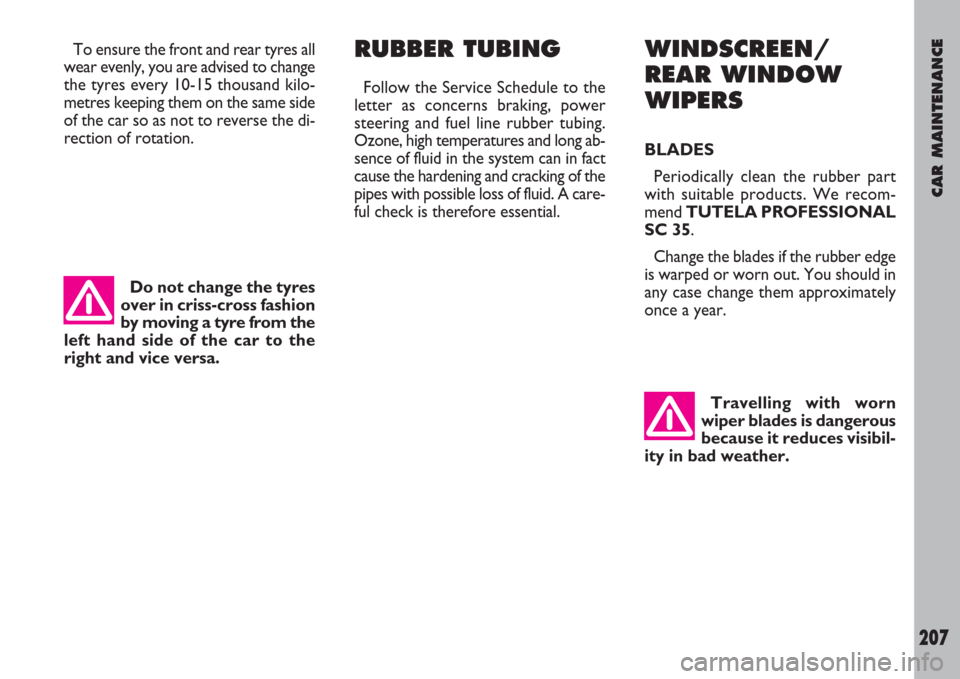
CAR MAINTENANCE
207
To ensure the front and rear tyres all
wear evenly, you are advised to change
the tyres every 10-15 thousand kilo-
metres keeping them on the same side
of the car so as not to reverse the di-
rection of rotation.RUBBER TUBING
Follow the Service Schedule to the
letter as concerns braking, power
steering and fuel line rubber tubing.
Ozone, high temperatures and long ab-
sence of fluid in the system can in fact
cause the hardening and cracking of the
pipes with possible loss of fluid. A care-
ful check is therefore essential.
WINDSCREEN/
REAR WINDOW
WIPERS
BLADES
Periodically clean the rubber part
with suitable products. We recom-
mend TUTELA PROFESSIONAL
SC 35.
Change the blades if the rubber edge
is warped or worn out. You should in
any case change them approximately
once a year. Do not change the tyres
over in criss-cross fashion
by moving a tyre from the
left hand side of the car to the
right and vice versa.
Travelling with worn
wiper blades is dangerous
because it reduces visibil-
ity in bad weather.
Page 209 of 254
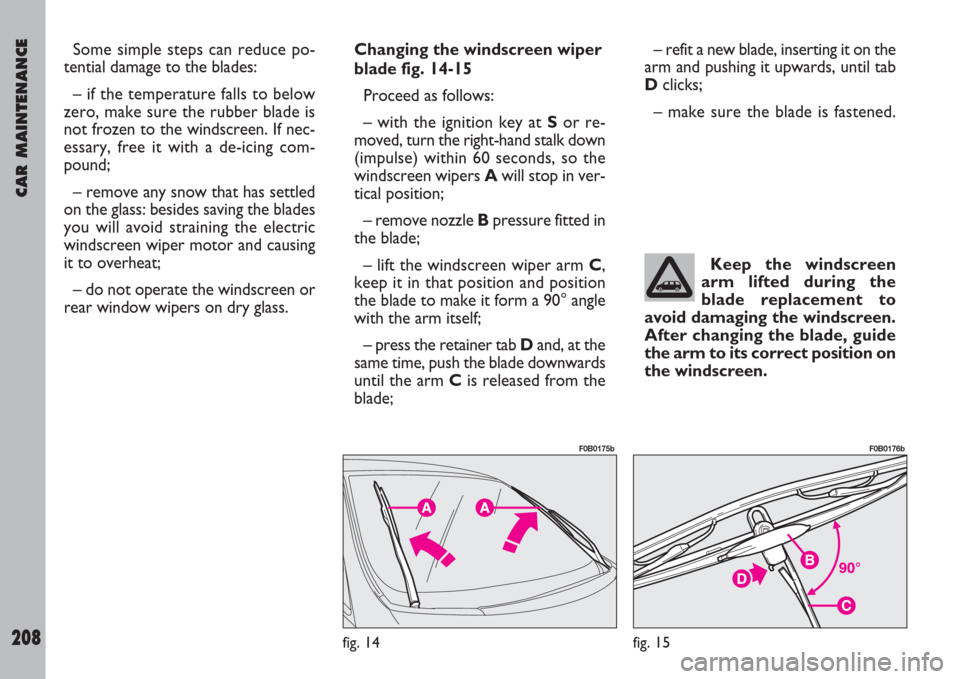
CAR MAINTENANCE
208
Some simple steps can reduce po-
tential damage to the blades:
– if the temperature falls to below
zero, make sure the rubber blade is
not frozen to the windscreen. If nec-
essary, free it with a de-icing com-
pound;
– remove any snow that has settled
on the glass: besides saving the blades
you will avoid straining the electric
windscreen wiper motor and causing
it to overheat;
– do not operate the windscreen or
rear window wipers on dry glass.Changing the windscreen wiper
blade fig. 14-15
Proceed as follows:
– with the ignition key at Sor re-
moved, turn the right-hand stalk down
(impulse) within 60 seconds, so the
windscreen wipers Awill stop in ver-
tical position;
– remove nozzle Bpressure fitted in
the blade;
– lift the windscreen wiper arm C,
keep it in that position and position
the blade to make it form a 90° angle
with the arm itself;
– press the retainer tab Dand, at the
same time, push the blade downwards
until the arm Cis released from the
blade;– refit a new blade, inserting it on the
arm and pushing it upwards, until tab
D clicks;
– make sure the blade is fastened.
Keep the windscreen
arm lifted during the
blade replacement to
avoid damaging the windscreen.
After changing the blade, guide
the arm to its correct position on
the windscreen.
fig. 14
F0B0175b
fig. 15
F0B0176b
Page 210 of 254
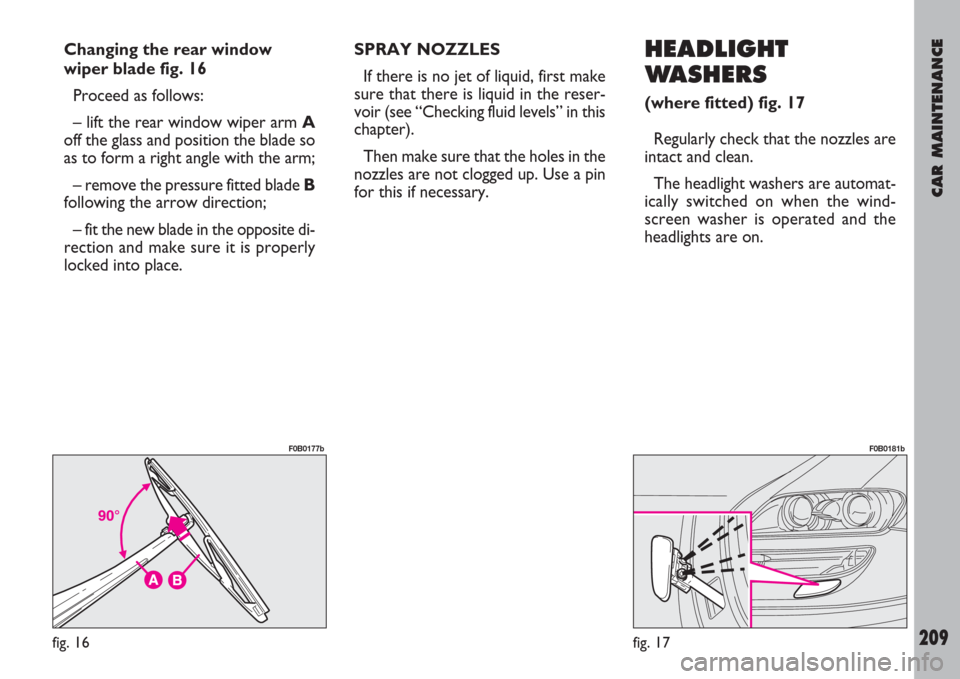
CAR MAINTENANCE
209
Changing the rear window
wiper blade fig. 16
Proceed as follows:
– lift the rear window wiper arm A
off the glass and position the blade so
as to form a right angle with the arm;
– remove the pressure fitted blade B
following the arrow direction;
– fit the new blade in the opposite di-
rection and make sure it is properly
locked into place.SPRAY NOZZLES
If there is no jet of liquid, first make
sure that there is liquid in the reser-
voir (see “Checking fluid levels” in this
chapter).
Then make sure that the holes in the
nozzles are not clogged up. Use a pin
for this if necessary.HEADLIGHT
WASHERS
(where fitted) fig. 17
Regularly check that the nozzles are
intact and clean.
The headlight washers are automat-
ically switched on when the wind-
screen washer is operated and the
headlights are on.
fig. 16
F0B0177b
fig. 17
F0B0181b